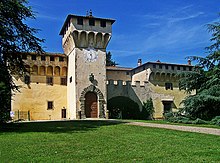Medici villa
 |
|
| UNESCO World Heritage Site | |
|---|---|
| Location | Italy |
| Coordinates | 43°51′28″N 11°18′15″E / 43.857778°N 11.304167°E |
| Criteria | Cultural: (ii), (iv), (vi) |
| Reference | 175 |
| Inscription | 2013 (37th Session) |
|
[]
|
|
The Medici villas are a series of rural building complexes in Tuscany which were owned by members of the Medici family between the 15th century and the 17th century. The villas served several functions: they were the country palaces of the Medici, scattered over the territory that they ruled, demonstrating their power and wealth. They were also recreational resorts for the leisure and pleasure of their owners; and, more prosaically, they were the centre of agricultural activities on the surrounding estates. In 2013, the Medici villas were added to UNESCO's World Heritage list.
The first Medici villas were the Villa del Trebbio and that at Cafaggiolo, both strong fortified houses built in the 14th century in the Mugello region, the original home of the Medici family. In the 15th century, Cosimo de' Medici built villas designed by Michelozzo at Careggi and Fiesole, still quite severe buildings, but with additional recreational spaces: courtyards, balconies, and gardens. Lorenzo de' Medici spent long periods at the Villa di Careggi. Gradually, Florence became surrounded by a collection of Medici villas, with others in more distant parts of the Grand Duchy of Tuscany. By the end of the 16th century, there were at least 16 major estates, with at least another 11 of secondary interest (mainly agricultural or owned by the Medici family for a short time), together with a constellation of farms and hunting lodges throughout Tuscany. Giusto Utens painted a series of lunettes depicting the main Medici villas in the 17th century, which are now held by the Museo di Firenze com'era.
The last Medici villas were the Villa di Montevettolini and the Villa di Artimino, bought in 1595/6 by Ferdinando I while he was expanding the Villa di Castello, Villa La Petraia and Villa dell'Ambrogiana.
...
Wikipedia

